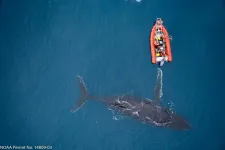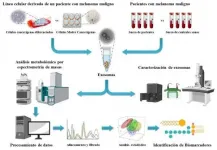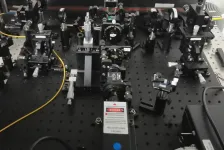INFORMATION:
The paper, published in the journal Endangered Species Research, is entitled: "Marine mammal conservation: Over the horizon."
Ocean's mammals at crucial crossroads
2021-03-25
(Press-News.org) The ocean's mammals are at a crucial crossroads - with some at risk of extinction and others showing signs of recovery, researchers say.
In a detailed review of the status of the world's 126 marine mammal species - which include whales, dolphins, seals, sea lions, manatees, dugongs, sea otters and polar bears - scientists found that accidental capture by fisheries (bycatch), climate change and pollution are among the key drivers of decline.
A quarter of these species are now classified as being at risk of extinction (vulnerable, endangered or critically endangered on the IUCN Red List), with the near-extinct vaquita porpoise and the critically endangered North Atlantic right whale among those in greatest danger.
Conservation efforts have enabled recoveries among other species, including the northern elephant seal, humpback whale and Guadalupe fur seal.
The international research team - led by the University of Exeter and including scientists from more than 30 institutions in 13 countries - highlight conservation measures and research techniques that could protect marine mammals into the future.
"We have reached a critical point in terms of marine mammal conservation," said lead author Dr Sarah Nelms, of the Centre for Ecology and Conservation on Exeter's Penryn Campus in Cornwall.
"Very few marine mammal species have been driven to extinction in modern times, but human activities are putting many of them under increasing pressure.
"Our paper examines a range of conservation measures - including Marine Protected Areas (MPAs), bycatch reduction methods and community engagement - as well as highlighting some of the species that are in urgent need of focus."
The researchers say 21% of marine mammal species are listed as "data deficient" in the IUCN Red List - meaning not enough is known to assess their conservation status.
This lack of knowledge makes it difficult to identify which species are in need of protection and what actions should be taken to save them.
Professor Brendan Godley, who leads the Exeter Marine research group, said: "To continue conservation successes and reverse the downward trend in at-risk species, we need to understand the threats they face and the conservation measures that could help.
"Technology such as drone and satellite imaging, electronic tags and molecular techniques are among the tools that will help us do this.
"Additionally, sharing best practice will empower us - and this is why we are so proud to be part of such a large and international group for this project."
ELSE PRESS RELEASES FROM THIS DATE:
Researchers capture first 3D super-resolution images in living mice
2021-03-25
WASHINGTON -- Researchers have developed a new microscopy technique that can acquire 3D super-resolution images of subcellular structures from about 100 microns deep inside biological tissue, including the brain. By giving scientists a deeper view into the brain, the method could help reveal subtle changes that occur in neurons over time, during learning, or as result of disease.
The new approach is an extension of stimulated emission depletion (STED) microscopy, a breakthrough technique that achieves nanoscale resolution by overcoming the traditional diffraction limit of optical microscopes. Stefan Hell won the 2014 Nobel Prize in Chemistry for developing this super-resolution imaging technique.
In Optica, The ...
Researchers reveal how lipids and water molecules regulate 5-HT receptors
2021-03-25
Serotonin, or 5-hydroxytryptamine (5-HT), is a kind of neurotransmitter. 5-HT can regulate multifaceted physiological functions such as mood, cognition, learning, memory, and emotions through 5-HT receptors. 5-HT receptors are a type of G protein-coupled receptor and can be divided into 12 subtypes in humans. As drug targets, they play a vital role in the treatment of schizophrenia, depression, and migraine.
However, the structural and functional mechanisms of 5-HT receptors have been largely unknown.
In a study published in Nature on March 24, Prof. H. Eric XU and Prof. JIANG Yi from the Shanghai Institute of Materia Medica (SIMM) of the Chinese Academy of ...
New biomarkers of malignant melanoma identified
2021-03-25
Their study has shown that these malignant melanoma vesicles produced by CSCs have a different molecular composition from that of differentiated tumour cells. These molecules were also found to be detectable in exosomes present in the blood, and they presented differences in patients with malignant melanoma compared to healthy individuals. This makes them potentially suitable as biomarkers for the diagnosis and prognosis of this disease.
The results have been published in the prestigious scientific journal Molecular Oncology.
Malignant melanoma is one of the most aggressive types of skin cancer and its prevalence has been increasing worldwide in recent years. Among the factors that contribute to the life-threatening nature and ...
New 'bi-molecule' with multiple technological applications discovered
2021-03-25
Dr. Rosario González-Férez, a researcher at the Department of Atomic, Molecular and Nuclear Physics and the "Carlos I" Institute of Theoretical and Computational Physics of the University of Granada, has published the article "Ultralong-Range Rydberg Bi-molecules" in the prestigious scientific journal Physical Review Letters. The results of the study show a new type of bi-molecule formed from two nitric oxide (NO) molecules, both in their ground state and in the Rydberg electronic state.
The work was made possible thanks to the scientific collaboration between the researcher and the Institute for Theoretical Atomic, Molecular ...
SMART develops rapid deterministic lateral displacement assay to assess immune response
2021-03-25
The novel label-free assay uses unconventional L and inverse-L shaped pillars of deterministic lateral displacement (DLD) microfluidic technology to quantify and profile immune states of white blood cells (WBCs) by assessing biophysical properties of size, deformation, distribution, and cell count
The assay requires only 20 microlitres (μl) of unprocessed blood and takes just 15 minutes - much faster than existing methods which require up to 15 millilitres (ml) of blood and take at least a few hours to produce results
This new technology measures and profiles the often volatile host immune response, resulting in a more accurate assessment of patient pathophysiology
Current methods for early diagnosis of infection focus on ...
The imaginary part of quantum mechanics really exists!
2021-03-25
For almost a century, physicists have been intrigued by the fundamental question: why are complex numbers so important in quantum mechanics, that is, numbers containing a component with the imaginary number i? Usually, it was assumed that they are only a mathematical trick to facilitate the description of phenomena, and only results expressed in real numbers have a physical meaning. However, a Polish-Chinese-Canadian team of researchers has proved that the imaginary part of quantum mechanics can be observed in action in the real world.
We need to significantly reconstruct our naive ...
New study sheds light on how X and Y chromosomes interact
2021-03-25
Researchers at Lund University in Sweden have investigated how the X and Y chromosomes evolve and adapt to each other within a population. The results show that breaking up coevolved sets of sex chromosomes could lead to lower survival rates among the offspring - something that could be of importance in species conservation, for example. The study is published in the journal PNAS.
The results provide new clues on how species are formed, and suggest it could be harmful to bring together individuals from different populations that have been separated for a long time. The reason is that the offspring have lower survival rates.
"This is something worth keeping in mind in conservation biology, where you want to see a population ...
Ancient megafaunal mutualisms and extinctions as factors in plant domestication
2021-03-25
By clearing forests, burning grasslands, plowing fields and harvesting crops, humans apply strong selective pressures on the plants that survive on the landscapes we use. Plants that evolved traits for long-distance seed-dispersal, including rapid annual growth, a lack of toxins and large seed generations, were more likely to survive on these dynamic anthropogenic landscapes. In the current article, researchers argue that these traits may have evolved as adaptations for megafaunal mutualisms, later allowing those plants to prosper among increasingly sedentary human populations.
The new study hypothesizes that the presence of specific anthropophilic traits explains why a select few plant families came to dominate the crop and weed ...
New documentation: Old-growth forest carbon sinks overestimated
2021-03-25
The claim that old-growth forests play a significant role in climate mitigation, based upon the argument that even the oldest forests keep sucking CO2 out of the atmosphere, is being refuted by researchers at the University of Copenhagen. The researchers document that this argument is based upon incorrectly analysed data and that the climate mitigation effect of old and unmanaged forests has been greatly overestimated. Nevertheless, they reassert the importance of old-growth forest for biodiversity.
Old and unmanaged forest has become the subject of much debate in ...
A divided cell is a doubled cell
2021-03-25
One big challenge for the production of synthetic cells is that they must be able to divide to have offspring. In the journal Angewandte Chemie, a team from Heidelberg has now introduced a reproducible division mechanism for synthetic vesicles. It is based on osmosis and can be controlled by an enzymatic reaction or light.
Organisms cannot simply emerge from inanimate material ("abiogenesis"), cells always come from pre-existing cells. The prospect of synthetic cells newly built from the ground up is shifting this paradigm. However, one obstacle on this path is the question of controlled division--a requirement for having "progeny".
A team from the Max Planck Institute for Medical Research in Heidelberg, Heidelberg ...





